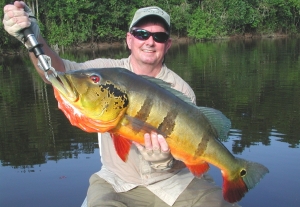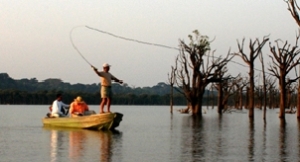Why go all the way to the Amazon, when they have peacock bass in Florida? Well, for the same reason it’s worth traveling 10 miles down the road to a river full of smallmouth bass instead of fishing for rock bass in the creek behind your house. The term bass is a catchall for several related but quite dissimilar fishes. They are very different animals in a very different environment. The peacock bass imported to Florida are about as similar to the Amazon giants as rock bass are to smallmouths. They are very different animals in a very different environment.

Amazon Peacock Bass attain enormous sizes
The venerable smallmouth, highly regarded as one of North America’s most sporting gamefish belongs to the family Centrarchidae, as does its smaller, meeker cousin, the rock bass. Although they are from the same branch of their family (let’s call them cousins) and they are both called bass, they are very different in form and have very different behaviors. (Perhaps you have a first cousin named, well, lets say “Fauntleroy”, whose hobby is collecting back issues of Home and Garden; See what I mean?)
The same analogy holds true for peacock bass. All of them belong to the family Cichlidae; Fifteen species comprise the genus Cichla and all of them are called peacock bass. Cichla ocellaris, also known in Florida as the butterfly peacock (lets think of them as the rock bass of the family, or maybe “Fauntleroy”, for the moment) were transplanted from waters of the Guyana shield region, (north of the Amazon main stem) into South Florida canals some 20 years ago. A strong, efficient predator for their size, they flourished in the region. Their native environment in cooler waters outside the lowlands Amazon basin made them temperature-tolerant enough to survive the cold spells common in subtropical Florida. They have been a good addition to south Florida’s freshwater fish population and they offer a nice alternative to the resident largemouths. But from a fisherman’s point of view, they are no comparison to the enormous beasts found in the Amazon.
Let’s compare them point by point in some of the more important parameters;
1. Size; No comparison here. Although Florida peacocks (Cichla ocellaris) can attain up to 10 lbs. in weight, a far more typical size is a pound or two. Their Amazon cousins (Cichla temensis) are beasts of a different magnitude, averaging 5 lbs. or more (depending on the river) with 15 lb. trophies common and with hulking monsters over 25 lbs. lurking in the Amazon’s blackwaters.
2. Feeding Behavior; Although not as obvious as the size differences, feeding behavior is what characterizes a gamefish and is probably the most significant indicator of fishing quality from the point of view of a sportfisherman. Florida peacocks tend to be subsurface feeders and can be extremely selective. Anglers find it often takes a live shiner to get their interest. Amazon peacocks, on the other hand are exclusively piscivorous feeders and are pursuit hunters. That means their target is fish and once they decide something is food, they’ll run it down halfway across a lagoon if they have to. And, unlike the Florida species, they aggressively strike lures on the surface, violently and with abandon, hence Larry Larsen’s famous description of “Peacock Bass Explosions”. This is probably the most exciting predatory attack of any sportfish in the world. No comparison here either. Frankly, no other fish compares, anywhere.
3. Habitat; Amazon peacocks are found in the most pristine and exotic habitat on earth. Jungle-lined blackwater rivers, hidden lagoons and white-sand scalloped beaches are just some of the spectacular settings in their native environment. The alien-appearing, isolated still waters lend a counterpoint to the sudden, violent and explosive attacks of these monsters. And, there are lots of other fish, ranging from acrobatic aruana to hulking giant catfish. Even if there were no fish at all, the stunning Amazon environment alone creates a hauntingly beautiful experience. Florida’s peacocks live in a wide range of very different water bodies, ranging from canals surrounding Miami airport, to residential development ponds, to the infield at Homestead race track. One might consider these to be exotic also, but in a very, very different way.
4. Environmental conditions; The central Amazon basin experiences a yearly water level pulsation, akin to a gigantic tide. With water levels rising and falling as much as 30 to 40 feet during each year, these fisheries undergo astounding changes. Amazon peacocks have evolved behaviorally in response to these unique conditions. They feed, spawn and undergo remarkable physical changes during these cycles. Most importantly, from a fisherman’s point of view, they become highly concentrated, aggressive, accessible and hungry during the falling water period. This creates optimal conditions for anglers and coincides, of course, with our fishing season. These conditions aren’t found outside of the Amazon, so Florida understandably provides a more homogenous fishing environment, without the extraordinary seasonal productivity associated with low water in the Amazon.
5. Price; Surely I’m kidding, right? There can’t be any comparison, can there? Well, believe it or not, fishing for peacocks in the Amazon costs about the same per day than the same length of excursion in Florida. Our Brazil trips provide about 6½ days of fishing and start from $3,650, or about $560 per day. That includes everything (except tipping); sumptuous meals, open bar 24/7, dedicated personal service, one of the world’s last great wildernesses and an unequalled fishing experience. What about Florida? You can expect a professional guide to ask for $375 to $550 per day (and sometimes you’ll pay extra for gas, lunch and bait as well). Let’s be economical and just call it $475. Now add in a motel, at least $60 a night, dinner and breakfast, if you eat cheap you can manage on $40, (and if you enjoy a cocktail in the evenings you’d better figure that in as well). We’re at $575 per day already, without even a cold beer, and you’ve got to admit you’re not quite getting the same ambiance for your money. Compare that to our trips. Go ahead, you do the math!

Amazon peacock bass are found in the most pristine waters on Earth.
There are many other points open for analysis, but I hope that by now it’s become clear that we’re not talking about the same type of fish or the same type of experience. All of this being said, I wouldn’t disparage the Florida peacock in any way. It’s a great fish in its own right. Pound for pound all peacocks are great fighters, displaying an unparalleled power and tenacity on rod and reel. Florida peacocks are no exception. They’re great fish when taken in context; they’re just not in the same league with the Amazon peacocks.
I’m not a purist, I just love to fish. I’m a pragmatic fisherman. When all that’s available to me are rock bass, I’m not proud; my bait will be in the water. As Steven Stills so famously and perhaps a little bit callously sang, “Love the one you’re with”. If I can’t be in Brazil, I’ll happily fish for Florida peacocks and if I can’t get to Florida, I’ll happily fish for one pound largemouths in my backyard pond or even rock bass in the creek, just as long as I’m fishing. But given the choice and the chance, count me in for the world’s greatest freshwater fighting fish, the Amazon peacock bass.
For more information, visit us at; www.acuteangling.com
Follow us on Twitter at; http://twitter.com/PeacockBass


